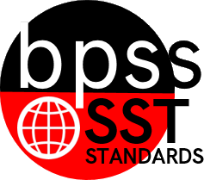6th Grade Standards
| (Prioritized Standards) |
SST-06.G
6-8 Social StudiesGeography DomainStandards
DescriptionThese geography standards are based on the Five Themes of Geography: Place, Movement, Regions, Location, and Human-Environment Interaction. These standards are written to give students a global perspective, which they can apply to other courses of study. Quality geography education is more than memorizing places on a map. It involves an understanding of various cultures, their motivations, and their connections to the global community. It also includes a deep understanding of how human beings have altered the landscape of the Earth over time, both physically and culturally. Calculation Method for DomainsDomains are larger groups of related Standards with benchmarks. So the Domain is a calculation of all the related standards that calculate to the benchmarks. So click on the benchmark identifier below each Standards to access the learning targets and proficiency scales for each standard. | |
SST-06.WH
6-8 Social StudiesWorld History Domain
DescriptionWorld history is about connections between people. Students need to understand how civilizations and cultures arose, developed, and interacted through conflict and peaceful exchange.
World history content is separated into four eras. The six standards for world history are the same for each era and are applicable to all eras of study. Benchmarks provide guidance on how to apply the standards to each era. The guiding topics column includes key topics fundamental to that era of study. It is the belief of the development committee that the guiding topics, while not required, illustrate multiple ways for students to successfully achieve the standards. World History Eras
Anchor Standards
Calculation Method for DomainsDomains are larger groups of related Standards with benchmarks. So the Domain is a calculation of all the related standards that calculate to the benchmarks. So click on the benchmark identifier below each Standards to access the learning targets and proficiency scales for each standard. | |
SST-06.WH_e1.b1SST-06.WH_e1.b1 Explain multiple achievements of civilizations and connect them to the present.Guiding Topics: River Valley (China, India, Mesopotamia, or Egypt), Greek, Roman, African, and Mesoamerican (Aztecs, Mayans, or Incas) civilizations Student Learning Targets:Knowledge Targets
Reasoning Targets
Skills (Performance) Targets
Product Targets
Proficiency ScaleThe Student can ...1 Beginning... with help, demonstrate a partial understanding of some of the simpler details and processes (Score 2.0 content) and some of the more complex ideas and processes (Score 3.0 content).
2 Developing... demonstrate no major errors or omissions regarding the simpler details and processes but exhibits major errors or omissions regarding the more complex ideas and processes (Score 3.0 content).
3 Proficient“The Standard.”... demonstrate no major errors or omissions regarding any of the information and processes that were end of instruction expectations.
4 Advanced... demonstrate in-depth inferences and applications regarding more complex material that go beyond end of instruction expectations.
ResourcesVocabulary
Websites
| |
SST-06.WH_e1.b3SST-06.WH_e1.b3 Explain the impact of the development of agriculture on the social, cultural, end economic lives of individuals.Guiding Topics: Agricultural Revolution, written language, inventions Student Learning Targets:Knowledge Targets
Reasoning Targets
Skills (Performance) Targets
Product Targets
Proficiency ScaleThe Student can ...1 Beginning... with help, demonstrate a partial understanding of some of the simpler details and processes (Score 2.0 content) and some of the more complex ideas and processes (Score 3.0 content).
2 Developing... demonstrate no major errors or omissions regarding the simpler details and processes but exhibits major errors or omissions regarding the more complex ideas and processes (Score 3.0 content).
3 Proficient“The Standard.”... demonstrate no major errors or omissions regarding any of the information and processes that were end of instruction expectations.
4 Advanced... demonstrate in-depth inferences and applications regarding more complex material that go beyond end of instruction expectations.
ResourcesVocabulary
Websites
| |
SST-06.WH_e1.b4SST-06.WH_e1.b4 Explain how political systems impacted the people in Greece and Rome and how those political systems connect to the present.Guiding Topics: Characteristics of civilizations Student Learning Targets:Knowledge Targets
Reasoning Targets
Skills (Performance) Targets
Product Targets
Proficiency ScaleThe Student can ...1 Beginning... with help, demonstrate a partial understanding of some of the simpler details and processes (Score 2.0 content) and some of the more complex ideas and processes (Score 3.0 content).
2 Developing... demonstrate no major errors or omissions regarding the simpler details and processes but exhibits major errors or omissions regarding the more complex ideas and processes (Score 3.0 content).
3 Proficient“The Standard.”... demonstrate no major errors or omissions regarding any of the information and processes that were end of instruction expectations.
4 Advanced... demonstrate in-depth inferences and applications regarding more complex material that go beyond end of instruction expectations.
ResourcesVocabulary
Websites
| |
SST-06.WH_e2.b1SST-06.WH_e2.b1 Explain the causes and effects of Medieval social structures using primary and secondary sources.Guiding Topics: Feudalism (European or Japanese), Magna Carta, rise of universities Student Learning Targets:Knowledge Targets
Reasoning Targets
Skills (Performance) Targets
Product Targets
Proficiency ScaleThe Student can ...1 Beginning... with help, demonstrate a partial understanding of some of the simpler details and processes (Score 2.0 content) and some of the more complex ideas and processes (Score 3.0 content).
2 Developing... demonstrate no major errors or omissions regarding the simpler details and processes but exhibits major errors or omissions regarding the more complex ideas and processes (Score 3.0 content).
3 Proficient“The Standard.”... demonstrate no major errors or omissions regarding any of the information and processes that were end of instruction expectations.
4 Advanced... demonstrate in-depth inferences and applications regarding more complex material that go beyond end of instruction expectations.
ResourcesVocabulary
Websites
| |
SST-06.WH_e2.b3SST-06.WH_e2.b3 Explain the emergence of cultural interaction between Europe and other civilizations.Guiding Topics: Crusades, Silk Roads, Marco Polo in China, Bubonic Plague, Mongol Invasions, or early explorations, humanism, the Renaissance Student Learning Targets:Knowledge Targets
Reasoning Targets
Skills (Performance) Targets
Product Targets
Proficiency ScaleThe Student can ...1 Beginning... with help, demonstrate a partial understanding of some of the simpler details and processes (Score 2.0 content) and some of the more complex ideas and processes (Score 3.0 content).
2 Developing... demonstrate no major errors or omissions regarding the simpler details and processes but exhibits major errors or omissions regarding the more complex ideas and processes (Score 3.0 content).
3 Proficient“The Standard.”... demonstrate no major errors or omissions regarding any of the information and processes that were end of instruction expectations.
4 Advanced... demonstrate in-depth inferences and applications regarding more complex material that go beyond end of instruction expectations.
ResourcesVocabulary
Websites
| |

